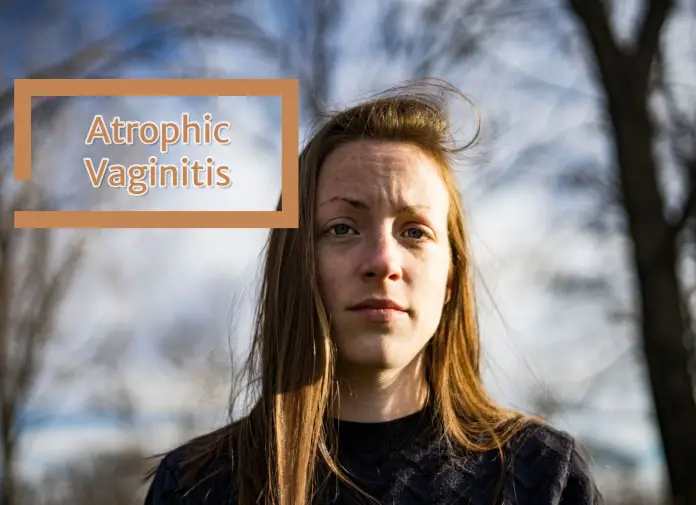If you’re over 40, then it’s possible that you must have heard of Atrophic Vaginitis or vaginal atrophy. It is the thinning of the walls of the vagina due to decreased estrogen levels. It most commonly occurs after a woman attains menopause.
Feeling wet or dry is mainly because of the mucus glands present in the walls of the vagina. During various stages of the menstrual cycle, the glands secrete different types of cervical mucus.
After a woman reaches her mid-40s, she is now in the perimenopause stage. The hormones regulating the menstrual cycle take a toll on the body.
Decreased levels of estrogen are the cause of postmenopausal atrophic vaginitis. Hot flashes, spotting after sex, dryness of vagina are consequences of vaginal atrophy.
Other consequences of atrophic vaginitis include pain during urination, infections, and painful sex.
What is atrophic vaginitis?
Postmenopausal atrophic vaginitis is the thinning of the walls of the vagina. The cause of vaginal atrophy is the falling levels of estrogen during menopause.
Once a woman attains menopause, she ceases to ovulate and does not get a period. The reason for no period is the lack of enough endometrial lining which sheds off during menstruation.
About 4 in every ten women in the menopause stags suffer from atrophic vaginitis. They have a higher chance of getting infections and bleeding during sexual intercourse.
When the levels of prolactin elevate during breastfeeding, lactational atrophic vaginitis may occur. The increase in prolactin suppresses other hormones.

Atrophic vaginitis symptoms
Symptoms of vaginal atrophy mainly include dryness of vagina and spotting. Itching and infections may occur due to rubbing while having sex or any other physical strain.
The feeling of dryness in the vagina makes one feel uncomfortable.
1) Dry vagina
Due to less mucus production vagina becomes dry. The vaginal wall is so thin that the glands don’t function properly.
As there is less lubrication sex becomes painful. Even when you insert tampon roughly or quickly, you may experience bleeding. The walls of the vagina become fickle and easily bleed.
2) Thinning of the vaginal wall
One may not be able to feel the thinning but observations like bleeding after sex or irregular period indicate insufficient lining.
The thinning of two walls of vagina leads to constricted vagina passage and can affect sex. The thickening or formation of endometrial lining depends on the circulating levels of estrogen.
The cause of atrophic vaginitis is low estrogen, and so thinning of the vaginal walls is foreseeable.
3) Painful sex
The vagina walls are so delicate in women having atrophic vaginitis that they may suffer from pain during sex.
Even the slightest force can cause the walls to bleed. The lack of sufficient lubrication further increases the friction during intercourse causing the walls of the vagina to bleed.
There is a loss of elasticity in the walls of the vagina and the external genitalia also become thin.
The uterine support tissue is no longer able to withstand the pressure and leads to loss of strength. All this hampers smooth, painless sex.
4) Urinary tract infections
Due to the dryness, the yeast-bacteria balance of vagina changes. The natural balance of the two maintains a pH healthy for vagina.
The increase of either bacteria or yeast causes bacterial vaginosis or candidiasis.
The infection can spread to surrounding regions and can cause infections in the urinary tract.
Burning and bleeding during urination is a sign of vaginal atrophy.
5) Inflammation of vagina
The walls of the vagina have inflammation and swelling in vaginal atrophy.
Urine incontinence occurs as a result because the urinary opening closes. Vaginal atrophy discharge is gooey, unlike the stringy cervical mucus during ovulation.
Any infections of the vagina or urinary tract can aggravate the inflammatory response.
6) Pain during urination
As the walls of the vagina have inflammation, they push the surrounding regions and lead to pain during urination.
7) Involuntary urination
Incontinence or involuntary leakage of urine is a complication of atrophic vaginitis. The constant wetness in the area is another reason for infections of UTI due to vaginal atrophy.
8) Spotting after sex or randomly
The walls of the vagina do not form properly and can bleed at any time. If a pre-menopausal woman gets atrophic vaginitis, then she may have an irregular period or spotting.
After sex or even pushing a dome or tampon inside there can be spotting.
9) Constriction of the vaginal passage
The walls of the vagina become thin and lead to shortening of the vaginal passage. The women suffering, who intend on getting pregnant, have to get a treatment of vaginal atrophy before conceiving.
10) Miscarriage, fertility issues
The declined levels of estrogen don’t allow pregnancy and even affect the regular menstrual cycle.
Even if due to some artificial supplements the lack of estrogen fulfills, atrophic vaginitis will still inhibit fertility.
Causes of atrophic vaginitis
There are many causes for atrophic vaginitis other than menopause. Anything that leads to the reduction in the level of estrogen comes under risk factors for vaginal atrophy.
1) Breastfeeding
During breastfeeding, the levels of prolactin suppress the ovulation hormones. Thus a breastfeeding mother can experience atrophic vaginitis for the time being.
2) Chemotherapeutic treatments
Chemotherapy for any cancer can affect the synthesis of estrogen. Out of the many side effects of chemotherapy atrophic vaginitis is the one that affects fertility.
3) Menopause
During menopause, most women have atrophic vaginitis due to a decline in estrogen. After 12 months of absence of menstruation, a woman is in the postmenopausal stage. By that time estrogen levels fall far below average.
4) Removal of ovaries
The removal of ovaries exerts negative feedback for hormones regulating the menstrual cycle. As ovulation hormones get affected the vaginal wall becomes thin.
Apart from the endometrial lining, the wall of the vagina becomes extremely thin.
5) Hormonal therapies
During breast cancer and birth control procedures, the artificial hormonal supplements affect the natural circulation in the body.
6) Feast or famine sex pattern
Not having sex is not a cause of atrophic vaginitis but regular sex or uniform pattern of having sex are less prone to it.
Atrophic vaginitis risk factors
Women who undergo c section delivery or have never delivered from vagina are at higher risk of having atrophic vaginitis.
Drugs that limit blood flow and smoking leads to hypoxia. When there is insufficient oxygen reaching a tissue, it leads to loss of function or necrosis.
The walls of the vagina receiving a low amount of blood or deprivation of oxygen become thin as blood is the medium to bring estrogen.
Atrophic vaginitis complications include UTI and pain during sex. Fertility issues may also arise if it is left untreated in premenopausal women.
Atrophic vaginitis diagnosis: How is Vaginal atrophy tested?
When should you see a doctor for atrophic vaginitis?
When you have pain during intercourse or are in the age group of women having menopause, you should see a doctor for vaginal atrophy.
Test for atrophic vaginitis includes a physical examination and smear tests. Your doctor will discuss your reproductive health history.
The doctor will question about your period and sexual intercourse patterns. You must tell him everything in detail such as the kind of pain during intercourse that you experience.
A woman who has not had a period for more than a year without the use of any pills is postmenopausal. So you must be aware of the last period you had and when.
The medical history discussion will also include talking about any incident of having cysts or tumors and undergoing any radiation therapy for it.
The doctor will also want to know about your menstrual and vaginal hygiene habits such as kind of products you use.
Some products interfere with and hamper estrogen production, and others may be the actual cause of inflammation.
You must clean your female parts to avoid feeling awkward which hampers diagnosis of atrophic vaginitis.
The doctor will see your external genitalia and look for symptoms such as
- Sparse pubic hair
- Shiny skin
- The skin inside the vagina is not smooth and instead has pleats and creases
- A constricted opening of the vagina
- Thin genitalia, and loose tissues
The doctor will also look for any bulges in the walls of the vagina which happens during a prolapse. While physical examination your doctor will touch and feel the elasticity of support tissues and walls.
If these physical signs are present, tests for atrophic vaginitis will be ordered.
Your doctor will ask you to get:
- Pelvic examination
- Pap smear test
- Vagina acidity test
- Blood test & Urine test to check for hormone levels and any UTI.
During the smear test, your doctor can either take the scrapping from the wall of the vagina or the cervical mucus for testing.
The doctor will observe it under a microscope for the presence of any pathogenic bacteria. The pH if the vagina is alps responsible for regulating the yeast bacteria balance of the area.
The doctor can record the pH of cervical mucus and secretions or pH paper reading from the vagina.
The estrogen levels will be confirmatory tests for detecting low estrogen which causes atrophic vaginitis.
Atrophic vaginitis treatment
Treatment of atrophic vaginitis involves restoring estrogen levels to normal through supplements. Gels and estrogen creams are also a part of treatment.
Moisturisers and pH neutral washes help make the vagina moist and cure the dryness.
As the levels of estrogen rise back to normal using replacement therapy the thinning of the wall reverses. The treatment does not take long, and you see results within a fortnight. The elasticity of the vagina comes back, and the support tissues are again agile.
Gradually cervical mucus secretion is back to normal and the condition cured.
Topical estrogen helps in targeted action, and there is less alteration in blood composition.
When you use estrogen patches or rings the estrogen moving into the blood to circulate is less. It mostly acts superficially, and there is less risk of having cancer of the endometrial lining.
However, when you are taking topical estrogen treatment, there can be bleeding. You must consult your doctor immediately. Estrogen-progesterone balance is vital for a woman’s reproductive tract.
Following are the treatments for atrophic vaginitis:
- Estrogen patches and rings: Estrogen rings placed in vagina release doses of estrogen for long periods. They any fall off, so you need to be careful. In some cases, you’ll have to take progestin too.
- Oral estrogen: Tablets of estrogen increase the level of the hormone more rapidly. They can allow you to take a higher dose of estrogen. Women who take oral estrogen are also prescribed progesterone. There is a higher risk of cancer and bleeding. You need to be alert and seek medical care if any such thing happens. Oral estrogen supplements will cure hot flashes and vaginal dryness.
- Moisturizers: Gels and mild, safe moisturizers will reverse the dryness and reduce inflammation. You will have to apply them frequently until the lining is moist. Later lifestyle changes will reduce your dependence on them.
- pH neutral washes: Prevention of atrophic vaginitis includes the use of medicinal products instead of scented washes. The perfumed soaps and washes are responsible for altering the pH of the vagina.
- Estrogen suppositories: An estrogen tablet inserted into the vagina every day helps overcome the lack of estrogen. When the condition is severe, then the dose is high, and later the frequency reduces.
- Estrogen creams: Just like patches one can apply estrogen creams to affected areas. You can use them in combinations with the above options for treatment. They are generally meant for night time application. When your condition is severe, and there is a need for a higher dose of estrogen, then combination therapy helps. Other than that, women who have a history of cancer or risk of cancer of endometrium need to resort to topical estrogen treatment.
Home remedies for atrophic vaginitis
While the above cure for vaginal dryness, heals atrophic vaginitis rapidly, atrophic vaginitis natural treatment has a long-term effect.
How to treat atrophic vaginitis?
Prevention and lifestyle changes for atrophic natural vaginitis treatment involve the use of vitamin supplements.
Vitamin E oil helps to bring back the elasticity of skin and reduce dryness. Wearing loose cotton clothes minimizes the irritation of the vagina lining.
Regular sex increases the circulation of blood to the vagina. Foreplay and allowing time for having sex helps to alleviate the symptoms of atrophic vaginitis naturally.
Quit smoking and exposure to any laser treatment is also a step to prevent atrophic vaginitis.
Black Cohosh and Aloe Vera detoxify and improve the section of hormones.










Lovely article
My dr says I have atrophic vaginitis because there is no bacteria in the urine culture. However, does this also come with elevated white blood cell count and fatigue? I feel like vaginitis isn’t the right diagnosis. I’m 62 but am dragging like I’m 80. No energy to spare, just enough to get the minimum chores done each day